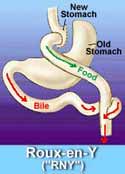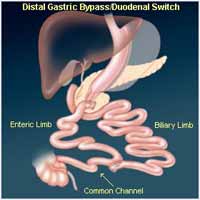Weight Loss Surgery: Bariatric Surgeries
There are many different types of Bariatric surgeries available. Here are some examples of surgeries that have become more popular.
- Restrictive procedures that decrease food intake.
- Malabsorptive procedures that alter digestion, causing food to be poorly digested and incompletely absorbed so that it is eliminated in the stool.
Gastric Bypass, Roux en-Y
This operation achieves its effects by creating a small stomach pouch from which the rest of the stomach is permanently divided and separated. The small intestine is cut and re-arranged to provide an outlet to the small stomach, while maintaining the flow of digestive juices at the same time. The lower part of the stomach is bypassed, and food enters the second part of the small bowel within about 10 minutes of beginning the meal.

After this type of surgery the patient will not have to eat a lot to feel full. There is no feeling of being deprived so patients can continue to eat whatever they want, however they’ll enjoy eating smaller portions. Gastric bypass surgery has been a successful tool for many patients to gain long-term control of their weight.
Laparoscopic Gastric Bypass, Roux en-Y
This type of gastric bypass surgery uses a small, light-weight, high-resolution video camera to allow surgeons to “see” into the abdomen using a pencil-thin optical telescope. The benefits are very small incisions which in turn causes less pain and little scarring.
Laparoscopic Adjustable Gastric Banding
This type of surgery is purely restrictive. A band is placed around the outside of the upper stomach which creates an hourglass shaped stomach. It is made of implantable silicone rubber containing an adjustable balloon. It can be inserted laparoscopically so the stomach is neither opened nor stapled. The effects of this type of surgery are not as profound as the gastric bypass however the recovery time is shorter.

Bilio Pancreatic Diversion
This type of surgery removes about two thirds of the stomach and re-arranges the intestinal tract so that the digestive enzymes are diverted away from the food stream until nearing the end of their passage through the intestine. It is effective in reducing absorption of fats and starches, while permitting near-normal absorption of protein and sugars. The result is a significant reduction in calorie intake without changing the portion of food that is eaten. A vitamin supplementation is necessary following the surgery because there is a risk of nutritional deficiencies of protein, certain vitamins and minerals. There is an essential dietary follow up program to limit fat and protein consumption.
Distal Gastric Bypass
This is a modified version of the gastric bypass that alters the absorption of food. This type of surgery effectively shortens the bowel available for absorption of food. It involves the combination of the very small stomach, which limits intake of food, with malabsorption of the nutrients which are eaten, reducing the intake of calories in food to a greater degree. The patient will experience more frequent bowel movements, increased fat in their stool, and more bowel gas. Vitamins are taken daily after surgery because Calcium absorption, and certain vitamins may be impaired.

Gastroplasty (Stomach Stapling, Gastric Stapling)
This type of surgery is accomplished by stapling the upper stomach to create a small pouch where food goes first after it is swallowed.
The outlet of this pouch is restricted by a band of synthetic mesh, which slows down its emptying; giving the patient a sense that he or she is full after only a few bites of their food. In this case, weight loss is determined by how much a person eats. Therefore, some patients who decide to snack all day instead of eat regular meals will not experience the benefits of this surgery.
Revision date: July 6, 2011
Last revised: by Dave R. Roger, M.D.